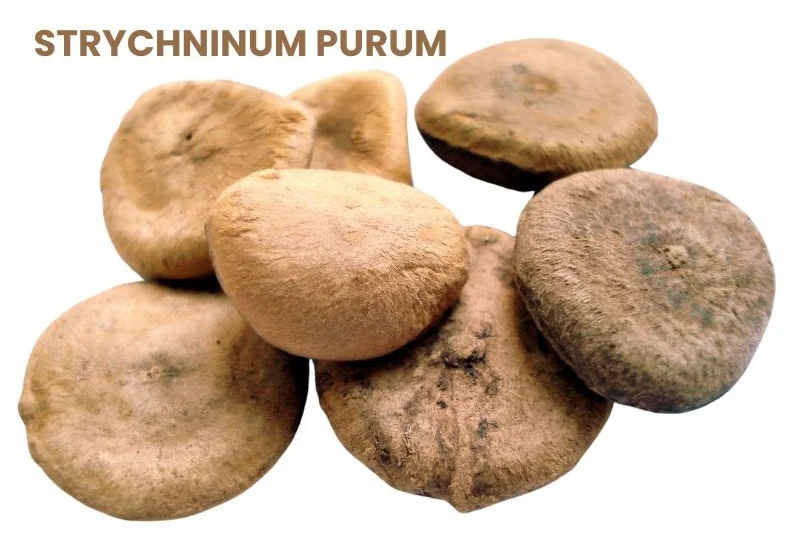Strychninum/Strychnos Nux-vomica, commonly known as Strychnine, is derived from the seeds of the Strychnos nux-vomica tree.
This substance is renowned for its powerful effects on the nervous system, particularly in its role as a stimulant.
In homeopathic practice, it is used to address various conditions related to muscular and nervous system dysfunction.

Table of Contents
ToggleSOURCE INFORMATION
Scientific Classification
- Kingdom: Plantae
- Order: Gentianales
- Family: Loganiaceae
- Genus: Strychnos
- Species: Strychnos nux-vomica
Origin
- Native to tropical regions of Asia, particularly India and Australia, the Strychnos nux-vomica tree produces seeds that have been utilized historically for their medicinal properties.
Historical Facts
- Traditionally, Strychnine has been used for its stimulant effects.
- It was historically used to treat a variety of conditions, including muscle weakness and paralysis.
- Its potent nature means it is handled with caution in both traditional and modern medicine.
DRUG PATHOGENESIS
Strychnine primarily affects:
- Nervous System: Increases the excitability and contractility of muscles, often used to address conditions related to paralysis and muscular atrophy.
- Respiratory System: Stimulates respiratory centers, making it useful in cases of breathing difficulties.
- Digestive System: Can influence gastrointestinal motility and digestion.
KEY CHARACTERISTICS
- Muscle Stimulant: Enhances muscle contraction and can be used to treat conditions involving muscle weakness or paralysis.
- Respiratory Stimulant: Aids in stimulating breathing, particularly useful in cases of respiratory distress.
- Antidote Properties: Can counteract the effects of certain poisons and toxic substances.
DETAILED ORGAN SYMPTOMS
FEVER
- Cold Chills: Chills running down the spine with an intense cold sensation in the lower extremities.
- Profuse Perspiration: Sweating heavily from the head and chest while the lower body remains cold.
SKIN
- Itching: Generalized itching over the entire body, notably around the nose.
- Icy Sensation: A cold feeling extending down the spine.
MODALITIES
- Worse: Symptoms worsen in the morning, with touch, noise, motion, and after meals.
- Better: Lying on the back alleviates symptoms.
WHAT ARE MODALITIES IN HOMOEOPATHY?
RELATIONSHIP WITH OTHER DRUGS
Compare,
EUCALYPTUS
- Helps neutralize some negative effects of Strychnine.
- Useful in counteracting symptoms that may arise from Strychnine use.
STRYCHNOS ARSENATE (Strych ars)
- Use: Effective for conditions like paresis in the elderly, relaxed muscles, and chronic symptoms.
- Symptoms: Prostration, psoriasis, chronic diarrhea with paralysis, early heart degeneration, severe dyspnea (breathing difficulty) when lying down, and oedema in lower limbs. It is also used for diabetes with scanty, high-specific-gravity urine.
- Potency: 6x trituration.
STRYCHNOS FERRUM CITRATE (Strych et Ferr cit)
- Use: Helps with chlorosis (iron deficiency anemia) and paralysis.
- Symptoms: Dyspepsia with vomiting of ingested food.
- Potency: 2x and 3x trituration.
STRYCHNOS NITRATE (Strychnin nit)
- Use: May reduce alcohol cravings.
- Potency: 2x and 3x trituration. Recommended for two weeks.
STRYCHNOS SULPHATE (Strychnin sulph)
- Use: Helps with gastric atony (weak stomach muscles).
STRYCHNOS VALERIANATE (Strych valerin)
- Use: Useful for exhaustion and nervousness.
- Symptoms: Women with high nervous sensitivity.
- Potency: 2x trituration.
CICUTA
- Comparable for treating tetanus.
- Also used for tetanus, similar to Strychnine.
DOSE
Homeopathic Use
- Potencies range from third to thirtieth. For specific symptoms, use based on homeopathic guidelines.
Non-Homeopathic Use
- Adults: One-fiftieth to one-twentieth of a grain, repeated three times a day.
- Children Under Twelve: One-fiftieth to one-two-hundredth of a grain.
- Emergency Use: For asphyxia or poisoning, one one-hundredth to one-sixtieth grain every three hours.
Frequently Asked Questions
What is the primary use of Strychnine in homeopathy?
- It is used for conditions involving muscular weakness, nervous system disorders, and respiratory distress.
How does Strychnine impact the body?
- It stimulates the nervous system, enhancing muscle contraction and breathing, and can act as an antidote for certain poisons.
What are the key modalities for Strychnine?
- Symptoms generally worsen in the morning, with motion, touch, noise, and after meals. Improvement is noted when lying on the back.
Glossary of Terms
- Systole: The phase of the heartbeat when the heart contracts.
- Diuretic: A substance that increases urine production.
- Anasarca: Generalized edema or swelling throughout the body.
- Dipsomania: An uncontrollable craving for alcohol.
- Gastric Atony: Reduced tone or motility of the stomach muscles.
